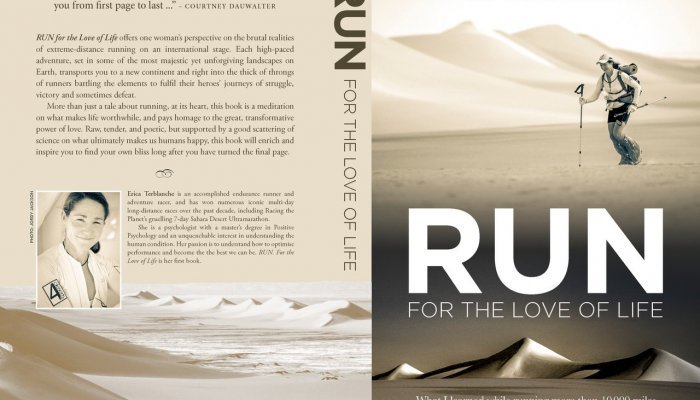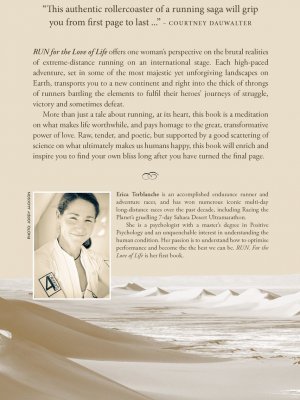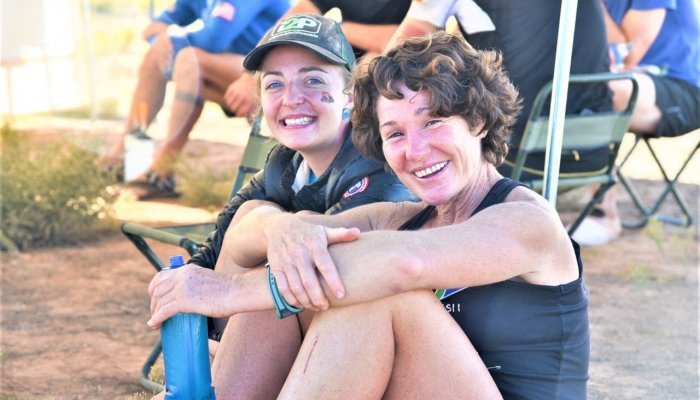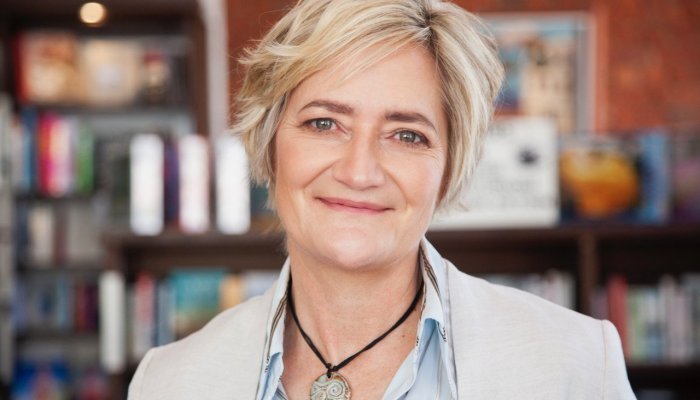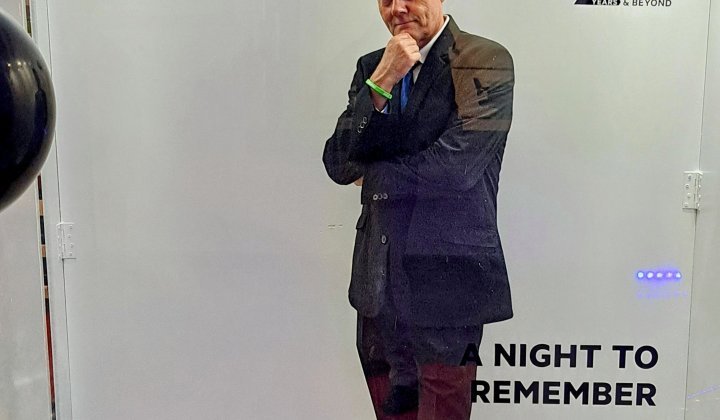“This is how you do it: you sit down at the keyboard and you put one word after another until it’s done. It's that easy, and that hard.” — Neil Gaiman, author
The author
Let’s start this story with a story …
Once upon a time, there was a girl called Erica Terblanche. Erica grew up in a place known as the “Big Smoke” (some people call it Johannesburg) and did all the normal things that normal girls do. Well, sort of, because she wasn’t just another girl.
The thing about Erica is that she had a dream. And there was another thing: Erica could run 100 miles without getting tired, and then keep going and going. For a while, Erica decided to live a normal life, but as we will see, that did not quite work out.
Here is where the endurance runner's epic tale started, in her own words …
“Let’s rewind to when I was about five years old. For Christmas, I got one of those small A5 diaries. It had a little golden key, and the diary could lock, and this made it so very special to me. This was the moment I knew I wanted to write more than anything else.
“The writing started off as a scrawl, but good enough for the diary, and that was good enough for me. I fell in love with the process of writing and ever since, for the rest of my school years, I would finish my homework as quick as a flash, collect my thoughts, and write them down.
“Just on 40 years later, Covid happened. I needed to somehow fill my days, so I stuck a piece of paper up in my kitchen. On it, I asked myself: what is it that I can write a story about that is fun, and exciting, and would inspire people? This was the exact moment my first book Run: For the Love of Life was born.
“Unlike many authors, I loved every second of the writing. It was only when I began trying to find an agent that I had a break-up with my book. That part of my journey sucked, so much so that I decided to save the book to my hard drive and forget about it.
“I figured I had already banked the personal joy of writing my story, so I never saw it as a complete loss. The universe had other plans, though, with my editor at the time, Michelle Bovey-Wood, phoning me in an absolute fury and refusing point blank [to give up on the idea of publishing]. (She used the phrase ‘over my dead body’ quite a few times).
“Michelle was adamant my story had to be told, so she’s the one who should be credited with getting my book onto the shelves. And there I was, suddenly, in that no-man’s where you have no choice but to publish or be damned!
“Here’s what I learned during the publishing process …
“What I did right while writing Run was not being ‘outcome-focused’. You need to authentically be blissed out in the journey of telling your story, rather than penning down thoughts in a race to reach your word count. Absolutely be in the journey: that's my biggest lesson when it comes to writing.
“Publishing is a whole different Scrabble game, though. This is not a solo journey, and you need a team of people around you if you’re serious about making a success. I had to make a call on whether to go with an agent, until Michelle connected me with Quickfox, a Cape self-publishing company. It was the best thing that could have happened.
“Taking control of the publishing process enabled me to get to market a good two years earlier than if I had chosen to work through an agent and traditional publisher. The main advantage is that the quality, look and overall feel of the final product was now completely in my hands.
“This goes for content as well: we had so many versions of the final edit that I lost count in the end, but Quickfox let me change it until it was ‘just right’, like Goldilocks’ porridge. The cover, the typeface, the paper, even what it felt like and smelled like – this was my book.
“That is priceless and is also the main reason I would recommend self-publishing to any new author. Another reason is ‒ to be honest ‒ that you will very rarely become rich from selling millions of books (unless you're a Stephen King, of course).
“A few final points: team up with a designer who really understands your story, because the old adage that a ‘picture speaking a thousand words’ holds true. The jacket is what buyers will see on shelf, while a quality printer plays a key role, too. They can make or break the economics and the quality of the book.
“I would absolutely, definitely, self-publish again. Mine was an incredible journey and, with the right partners, it becomes so much more gratifying. In most cases, the alternative is to willy-nilly hand your book over to a corporate team who take little interest in who you are, what your book stands for, or the story you want to tell.
“In the end, the partners who worked with me to publish Run: For the Love of Life created an exquisitely nuanced and beautiful product. It is a book I’m immensely proud of, as I am of the story contained between those covers.”
Six key publishing tips
Vanessa Wilson is the general manager of Quickfox Publishing. Quickfox offers a one-stop, independent publishing service offering authors a network of trusted professionals with whom to team up. Vanessa also established an online bookstore for all authors and basic advice on self-publishing ‒ learn more at www.quickfox.co.za.
Vanessa started her career three decades ago as a graphic designer, working mostly on publications. In 2007, she started her own design and publishing business, and continued working as a freelancer in publishing, immersing herself in all aspects of the field. These are her six key publishing tips.
Step 1: Let’s get real – why do you want to publish?
First off, be very clear whether a book is the best format in which to share your story. There are many reasons first-time authors come up with for writing their book, from “making money” or “establishing themself as experts in a specific field” to “sharing valuable skills”.
These are valid reasons, but there are different ways to achieve them, too. The alternatives to a book may be (a) much cheaper and (b) require less effort than the publishing route. Blogs or YouTube channels are just a couple of examples, and with these you could monetise your knowledge through a subscription fee or generate income through workshops and courses.
Sadly, publishing most likely will not make you any money (unless it happens to be that flash-in-the-pan bestseller). Average sales for self-publishing authors range from 200 to 500 copies. That said, if you manage your output costs, that may be enough to break even. So, there is your silver lining!
Step 2: Start at the end and work backwards
Fast-forward to your book on-shelf and imagine the person who’ll most likely buy it. How big is that market? Is it a niche group? What would they think is a fair price to pay for the book? If you’re planning to write your life story, would it be interesting enough beyond your family and immediate group of friends to sell effectively?
A book with broader appeal (let’s say, overcoming addiction), means you’re competing with a range of similar books, many from authors already well established in the market. The bottom line is, if you believe you can sell a few hundred books directly to potential readers (and subvert the expensive distribution process and eliminate the cut taken by bookstores), you have enough reason to push the “publish” button.
Step 3: Calculate your publishing budget and draw up a business plan
Drawing up a business plan for your book should be step one if you’re doing this to make profit. Standard business plan templates are available free of charge on the internet and will help you navigate the intricacies of a publishing project, from defining target markets, calculating costs, finding a USP for your book, and information on how to market and promote it.
Step 4: Invest in a professional editorial and production team
The success of your book may well be based on a solid storyline, but good editing and proof-reading is what will set it apart. This is about much more than fixing grammar, punctuation and spelling, and a top team will help you evaluate structure, flow and idea development. Finally, make sure you write for your reader and not yourself – this should guide every one of the editorial decisions you make.
Step 5: Choose the right author services company
There are five key ways to publish your book: custom publishing (or platform publishing); vanity (or package-based) publishing; self-publishing, print-on-demand (or DIY publishing); subsidy (or partnership) publishing; and finally, traditional publishing. The scope of this article only covers self-publishing, but whatever you do, choose a company that can print locally so that you cut out middlemen and reduce costs.
Step 6: Promote, promote, promote!
Your mission as a self-publishing author – regardless of which service you use – is to search for every opportunity to market and promote your book. It needs exposure: you now own a small business, and your product is a book. People need to know about it to buy it: enter it in competitions, conduct local talks and interviews, inform every book club in the country, send out mailers, be active on social media and ‒ if funds allow ‒ hire a publicist.





